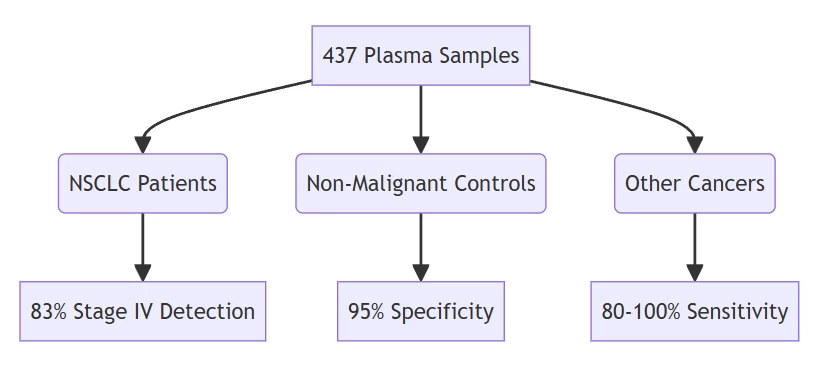 I. Technical Foundations: Overcoming cfRNA Detection Barriers
I. Technical Foundations: Overcoming cfRNA Detection Barriers
RARE-seq (Random priming and Affinity capture of cfRNA fragments for Enrichment analysis by sequencing) represents a quantum leap in cell-free RNA (cfRNA) analysis by addressing three fundamental challenges:
-
- Ultra-Low Abundance Capture
- Traditional RNA-seq fails to detect tumor-derived cfRNA (ctRNA) below 0.5% abundance
- RARE-seq achieves 0.05% detection sensitivity through molecular probes targeting 4,737 low-abundance genes minimally expressed in healthy blood ( (
(Fig. 1: RARE-seq workflow with affinity capture)
Description: Schematic showing magnetic bead-based enrichment of rare transcripts excluded by conventional methods.
- Platelet Interference Elimination

- *Proprietary bioinformatics filters remove >90% of hematopoietic noise (
- Pre-Analytical Optimization
Variable Conventional Protocol RARE-seq Enhancement Blood Collection EDTA tubes Customized RNA-stabilizing tubes RNA Extraction Column-based Phase-separation with inhibitor cocktails Library Prep Standard adapters Optimized fragmentation/ligation chemistry
II. Oncology Applications: Redefining Cancer Diagnostics
A. Early-Stage Tumor Detection
- Non-Small Cell Lung Cancer (NSCLC):
- Stage I detection sensitivity: 30% (vs. <5% with ctDNA)
- Progressive sensitivity increase to 83% in Stage IV ( (
- Pan-Cancer Screening:
- 95% specificity across hepatocellular, pancreatic, and prostate carcinomas (
(Fig. 2: RARE-seq detection rates by cancer stage)
Description: Bar graph showing increasing sensitivity from Stage I to IV cancers.
- 95% specificity across hepatocellular, pancreatic, and prostate carcinomas (
B. Treatment Resistance Monitoring
- EGFR-TKI Resistance:
- Identifies MET amplification signatures in ctDNA-negative patients (
- Detects small-cell transformation via ASCL1 overexpression (
- Dynamic Therapy Response:
- Tracks evolving resistance mutations with bi-weekly blood draws (
C. Tissue-of-Origin Tracing
- Cancers of Unknown Primary (CUP):
- 85% accuracy in top-predicted tissue origin (
- 96% accuracy within top two predictions (
III. Beyond Oncology: Multi-Disease Diagnostics
A. Infectious Disease Profiling
Pathogen RARE-seq Biomarker Clinical Utility SARS-CoV-2 IFIT1, OAS1 overexpression Early detection pre-seroconversion mRNA Vaccines Vaccine-derived RNAs Persistence tracking >6 weeks post-injection ( B. Chronic Organ Damage Assessment
- Pulmonary Injury:
- Detects SFTPB and AGER elevations in ventilator-induced damage (
- Smoker’s Lung:
- Identifies premalignant changes via GATA6 dysregulation (
IV. Technical Validation & Comparative Performance
A. Sensitivity Benchmarking
Method Detection Limit Platelet Resistance Standard RNA-seq 2.5% Low RARE-seq 0.05% High ( B. Clinical Specimen Analysis

V. Emerging Applications & Future Directions
A. Real-Time Treatment Personalization
- Closed-Loop Monitoring:
- Continuous cfRNA analysis via implantable microfluidic sensors
- AI-driven adaptive therapy adjustments (
B. Non-Invasive Prenatal Diagnostics
- Fetal Development Tracking:
- Detects placental RNA signatures for preeclampsia risk assessment
- Identifies neural tube defects via AFP isoforms (
(Fig. 3: Multi-disease diagnostic dashboard)
Description: Radar plot showing RARE-seq efficacy across cancer, infectious diseases, and organ injury.
Conclusion: The cfRNA Paradigm Shift
RARE-seq catalyzes four transformative advances:
- Early Cancer Interception – Stage I detection previously deemed impossible
- Resistance Evolution Mapping – Real-time monitoring of tumor adaptation
- Multi-Disease Liquid Biopsies – Unified platform for oncology, virology, and chronic disease
- Therapy Optimization – Dynamic treatment adjustments via longitudinal profiling
“RARE-seq transforms blood from a diagnostic medium into a real-time cellular broadcast system – decoding systemic biology through the lens of cfRNA dynamics.”
— Nature Review Molecular DiagnosticsCommercialization efforts led by Stanford innovators aim to deploy clinic-ready platforms by 2026, with single-test costs comparable to standard NGS panels.
Data sourced from publicly available references. For collaboration or domain acquisition inquiries, contact: chuanchuan810@gmail.com.
- Ultra-Low Abundance Capture
